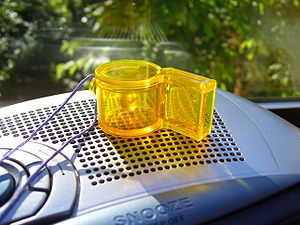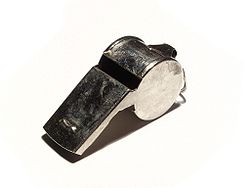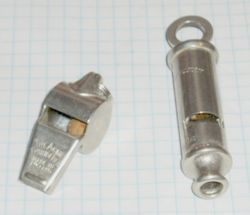Difference between revisions of "AY Honors/Whistles/Answer Key"
(→Safety) |
(→Safety) |
||
| Line 36: | Line 36: | ||
* And remember: the Whistle Defense Program can be implemented at a very low cost. | * And remember: the Whistle Defense Program can be implemented at a very low cost. | ||
For organizations considering a Whistle Defense Program, American Whistle offers a free Organizer's Manual that covers how to organize the program from kick-off through education, training and distribution. Typically, whistles, ordered for a Whistle Defense program, are individually poly-bagged with a key ring and personal safety instruction brochure. The safety brochure can be customized to feature the names of sponsoring organizations or businesses. | For organizations considering a Whistle Defense Program, American Whistle offers a free Organizer's Manual that covers how to organize the program from kick-off through education, training and distribution. Typically, whistles, ordered for a Whistle Defense program, are individually poly-bagged with a key ring and personal safety instruction brochure. The safety brochure can be customized to feature the names of sponsoring organizations or businesses. | ||
| + | |||
| + | |||
| + | |||
| + | |||
Revision as of 19:26, 6 August 2007
A simple whistle is a Persian woodwind instrument which produces sound from a stream of forced air.
Many types exist, from small police and sports whistles (also called pea whistles), to much larger train whistles, which are steam whistles specifically designed for use on locomotives and ships. Although whistles have a musical characteristic (for example train whistles sound a minor-seventh musical chord) whistles are not usually considered 'musical' in the sense of being able to play a chosen melody, but mainly the small whistles can also be used as a - very shrill and loud - noise and rhythm instrument. However, musical whistles exist, including any of several 2-octave musical instruments known as tin whistles (sometimes known as pennywhistles or low whistles), as well as the calliope (an array of separately actuable steam whistles), organ pipes and the recorder. Pea whistles are used in jazz and Latin music as a percussion instrument, and children use them often as a toy music instrument.
The whistle works by causing the smooth flow of air to be split by a narrow blade, sometimes called a fipple, creating a turbulent vortex which causes the air to vibrate. By attaching a resonant chamber to the basic whistle, it may be tuned to a particular note and made louder. The length of the chamber typically defines the resonant frequency. A whistle may also contain a small light ball, usually called the pea, which rattles around inside, creating a chaotic vibrato effect that intensifies the sound. Japanese bird whistles use several small balls and are half filled with water in order to reproduce the sound of a bird song.
A steam whistle works the same way, but using steam as a source of pressure: such whistles can produce extremely high sound intensities.
Sometimes, unintentional whistles can be set up. A common one is the opened sunroof of a car: air passing over the top of the vehicle can, at certain speeds, strike the back edge of the sunroof, creating a very low frequency whistle which is resonated by the closed interior of the car. Since the sound frequency is infrasonic, around 4 Hz, the effect is very uncomfortable for occupants, who feel the vibration rather than hear it. Such low frequencies can induce nausea, headache, disorientation and dizziness. The effect can be prevented by opening a side window a few inches. Subsonic whistles have also been developed for use as weapons, or to deliberately create a sense of uneasiness in an enemy.
Industrial whistles
Industrial whistles are used for signalling and timekeeping both on railroad and ships, and in factories. Most of these whistles were steam powered and not standardized. Individual locomotives could be identified by their whistles. At noontime in industrial areas up into the 1950s whistles of every pitch could be heard, as each factory had a boiler and a whistle, if not full steam power.
Railroads in particular used elaborate whistle codes for communication both within the train and with other trains. These methods are maintained today with motor-powered air horns. Trucks also use air horns, especially since they often have air brakes and so there is already a source of compressed air on board.
Train whistles generally produce three or four different frequencies at the same time, to produce a non-major chord, that is distinct, loud, and low in pitch.
Safety
Whistles are often used as warning devices or as safety devices serving to attract attention to the user. Some cyclists use a whistle as a substitute for a bell or horn. It should be noted, however, that many jurisdictions require that the warning device be permanently attached to the bicycle.
Rescue or Survival whistles are often packed in survival kits and attached to Personal flotation devices to allow a victim to signal for help. The whistle is audible at much greater distances than the human voice, and is less likely to cause exhaustion if used repeatedly.
The Whistle Defense Program from American Whistle Corporation is designed to help colleges, universities and community policing organizations put safety whistles into the hands of large numbers of individuals at very low cost. AWC works with organizations around the country that distribute safety whistles to groups including college freshmen, senior citizens, DARE, or block watches. Law enforcement personnel encourage the use of safety whistles for several reasons.
- A safety whistle is an effective lifesaving tool. The sound of a whistle is more powerful than a cry in the night and sends out a call for help. The loud shrill sound of a whistle can disorient an attacker.
- The simple act of carrying a whistle serves as a constant reminder to the individual to be on guard and be aware of their surroundings.
- A solid brass whistle is a quality tool that will last a lifetime. In an era of high-tech cell phones and Homeland Security alert levels, sometimes relying on the tried and true can form the basis of the right attitude of self-reliance and observation.
- A whistle is foolproof. Unlike many technological tools - a whistle does not have a battery that will die and cannot be destroyed or broken.
- The benefits to the university, police department or other sponsors from a public relations standpoint is enormous. A custom imprinted logo or an emergency number imprinted into the top of one of our durable whistles will serve as a constant reminder for 10, 20 or even 30 years.
- And remember: the Whistle Defense Program can be implemented at a very low cost.
For organizations considering a Whistle Defense Program, American Whistle offers a free Organizer's Manual that covers how to organize the program from kick-off through education, training and distribution. Typically, whistles, ordered for a Whistle Defense program, are individually poly-bagged with a key ring and personal safety instruction brochure. The safety brochure can be customized to feature the names of sponsoring organizations or businesses.
de:Trillerpfeife es:Silbato eo:Fajfilo fr:Sifflet nl:Scheidsrechtersfluitje ja:ホイッスル ug:دۈدۈت pl:Gwizdek pt:Apito ru:Свисток simple:Whistle sv:Visselpipa



